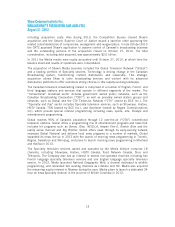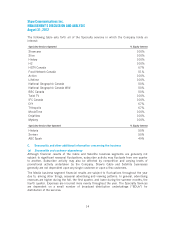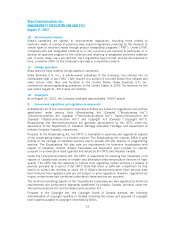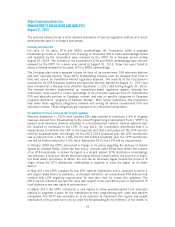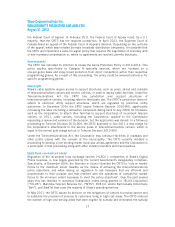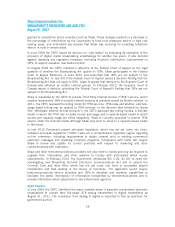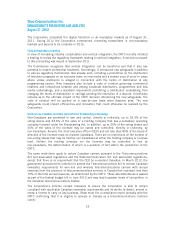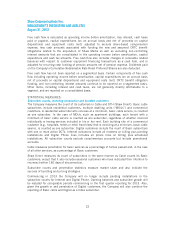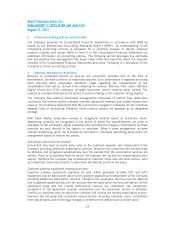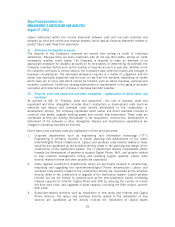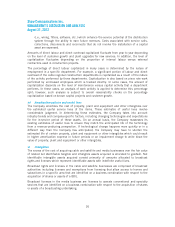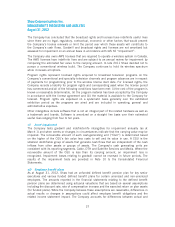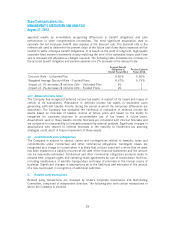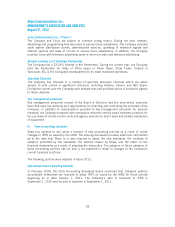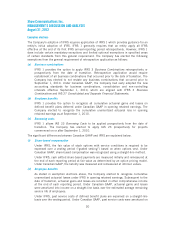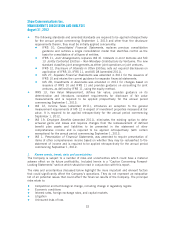Shaw 2012 Annual Report Download - page 26
Download and view the complete annual report
Please find page 26 of the 2012 Shaw annual report below. You can navigate through the pages in the report by either clicking on the pages listed below, or by using the keyword search tool below to find specific information within the annual report.Shaw Communications Inc.
MANAGEMENT’S DISCUSSION AND ANALYSIS
August 31, 2012
Free cash flow is calculated as operating income before amortization, less interest, cash taxes
paid or payable, capital expenditures (on an accrual basis and net of proceeds on capital
dispositions) and equipment costs (net), adjusted to exclude share-based compensation
expense, less cash amounts associated with funding the new and assumed CRTC benefit
obligations related to the acquisition of Shaw Media as well as excluding non-controlling
interest amounts that are consolidated in the operating income before amortization, capital
expenditure and cash tax amounts. Free cash flow also includes changes in receivable related
balances with respect to customer equipment financing transactions as a cash item, and is
adjusted for recurring cash funding of pension amounts net of pension expense. Dividends paid
on the Company’s Cumulative Redeemable Rate Reset Preferred Shares are also deducted.
Free cash flow has not been reported on a segmented basis. Certain components of free cash
flow including operating income before amortization, capital expenditures (on an accrual basis
net of proceeds on capital dispositions) and equipment costs (net), CRTC benefit obligation
funding, and non-controlling interest amounts continue to be reported on a segmented basis.
Other items, including interest and cash taxes, are not generally directly attributable to a
segment, and are reported on a consolidated basis.
STATISTICAL MEASURES:
Subscriber counts, including penetration and bundled customers
The Company measures the count of its customers in Cable and DTH (Shaw Direct). Basic cable
subscribers include residential customers, multiple dwelling units (“MDUs”) and commercial
customers. A residential subscriber who receives at a minimum, basic cable service, is counted
as one subscriber. In the case of MDUs, such as apartment buildings, each tenant with a
minimum of basic cable service is counted as one subscriber, regardless of whether invoiced
individually or having services included in his or her rent. Each building site of a commercial
customer (e.g., hospitals, hotels or retail franchises) that is receiving at a minimum, basic cable
service, is counted as one subscriber. Digital customers include the count of Basic subscribers
with one or more active DCTs. Internet customers include all modems on billing plus pending
installations and Digital Phone lines includes all phone lines on billing plus scheduled
installations. All subscriber counts exclude complimentary accounts but include promotional
accounts.
Cable measures penetration for basic services as a percentage of homes passed and, in the case
of all other services, as a percentage of Basic customers.
Shaw Direct measures its count of subscribers in the same manner as Cable counts its Basic
customers, except that it also includes seasonal customers who have indicated their intention to
reconnect within 180 days of disconnection.
Subscriber counts and penetration statistics measure market share and also indicate the
success of bundling and pricing strategies.
Commencing in 2013 the Company will no longer include pending installations in the
subscriber counts for Internet and Digital Phone. Opening balances and subscriber growth will
be restated for comparable periods commencing in the first quarter reporting for 2013. Also,
given the growth in and penetration of Digital customers, the Company will also combine the
reporting of Basic cable and Digital as a Video subscriber.
22



